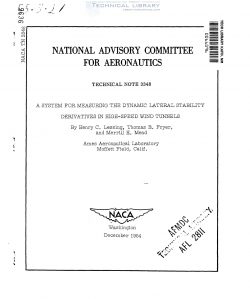naca-tn-3348
- Version
- 30 Downloads
- 1.40 MB File Size
- 1 File Count
- January 23, 2017 Create Date
- January 23, 2017 Last Updated
National Advisory Committee for Aeronautics, Technical Notes - A System for Measuring the Dynamic Lateral Stability Derivatives in High Speed Wind Tunnels

A two-degree-of-freedom system, in which rolling oscillations are
forced, is described. Details of the system, the theory, and the method
of operation are discussed. It is shown that, although the system is
characterized by nonlinear equations of motion, linearization of the
equations by assuming small perturbations and constant coefficients yields
sufficiently accurate results.
The accuracy Of the system was first investigated in tests under
idealized conditions in which the aerodynamic derivatives were simulated
by the action of gyroscopes and magnetic dampers. Later, the system was
investigated in a high—speed wind tunnel using a simple model for which the
aerodynamic derivatives could be estimated.
The results of the tests showed that the quantities relating to the
primary mode of operation of the system, that is, the rolling velocity
derivatives, could be Obtained satisfactorily. The same is true of the
directional stability and the damping-in-yaw derivatives. Results obtained
from the data-reduction equations for the rolling moment due to yawing
velocity and due to sideslip angle were unreliable, however, and prevented
the evaluation of these derivatives.
The increasing emphasis placed on studies of the dynamic stability
of aircraft has intensified the need for satisfactory methods for predict—
ing the dynamic stability derivatives. Most theoretical methods evolved
to date are subject to limitations imposed to reduce the mathematical
task to reasonable proportions. In order to Obtain experimental checks
of these methods and to provide sources of information in those areas in
which theoretical methods are not yet available, there exists a need for
experimental research on the stability derivatives.
The experimental study of dynamic stability derivatives in wind tun—
nels is, of course, not new. Many systems have been evolved for this
purpose. References l, 2, and 3, for instance, discuss early British
systems in which the relative motion of the model and the air stream is
generated by model motion. A dynamic system recently developed at Ames
Aeronautical Laboratory is described in reference h; again the relative
motion of the model and the air stream is generated by model motion.
| File | Action |
|---|---|
| naca-tn-3348 A System for Measuring the Dynamic Lateral Stability Derivatives in High Speed Wind Tunnels.pdf | Download |
Comment On This Post